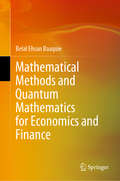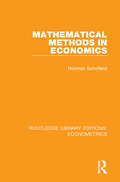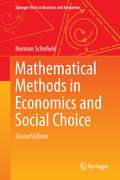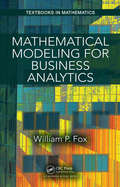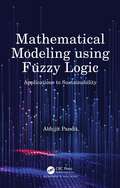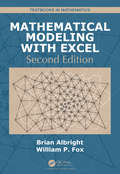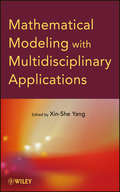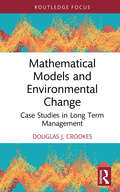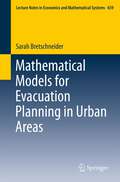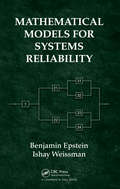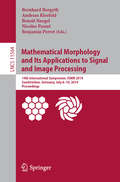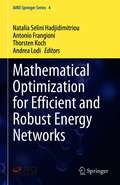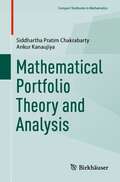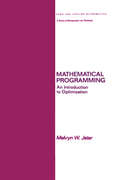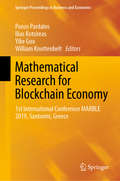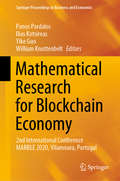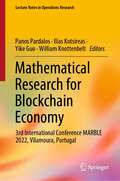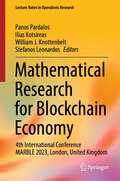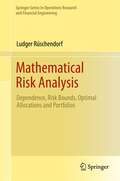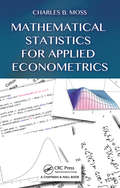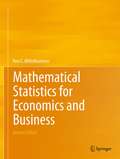- Table View
- List View
Mathematical Methods and Quantum Mathematics for Economics and Finance
by Belal Ehsan BaaquieGiven the rapid pace of development in economics and finance, a concise and up-to-date introduction to mathematical methods has become a prerequisite for all graduate students, even those not specializing in quantitative finance. This book offers an introductory text on mathematical methods for graduate students of economics and finance–and leading to the more advanced subject of quantum mathematics. The content is divided into five major sections: mathematical methods are covered in the first four sections, and can be taught in one semester. The book begins by focusing on the core subjects of linear algebra and calculus, before moving on to the more advanced topics of probability theory and stochastic calculus. Detailed derivations of the Black-Scholes and Merton equations are provided – in order to clarify the mathematical underpinnings of stochastic calculus. Each chapter of the first four sections includes a problem set, chiefly drawn from economics and finance. In turn, section five addresses quantum mathematics. The mathematical topics covered in the first four sections are sufficient for the study of quantum mathematics; Black-Scholes option theory and Merton’s theory of corporate debt are among topics analyzed using quantum mathematics.
Mathematical Methods for Finance: Tools for Asset and Risk Management (Frank J. Fabozzi Series)
by Frank J. Fabozzi Sergio M. Focardi Turan G. BaliThe mathematical and statistical tools needed in the rapidly growing quantitative finance field With the rapid growth in quantitative finance, practitioners must achieve a high level of proficiency in math and statistics. Mathematical Methods and Statistical Tools for Finance, part of the Frank J. Fabozzi Series, has been created with this in mind. Designed to provide the tools needed to apply finance theory to real world financial markets, this book offers a wealth of insights and guidance in practical applications. It contains applications that are broader in scope from what is covered in a typical book on mathematical techniques. Most books focus almost exclusively on derivatives pricing, the applications in this book cover not only derivatives and asset pricing but also risk management—including credit risk management—and portfolio management. Includes an overview of the essential math and statistical skills required to succeed in quantitative finance Offers the basic mathematical concepts that apply to the field of quantitative finance, from sets and distances to functions and variables The book also includes information on calculus, matrix algebra, differential equations, stochastic integrals, and much more Written by Sergio Focardi, one of the world's leading authors in high-level finance Drawing on the author's perspectives as a practitioner and academic, each chapter of this book offers a solid foundation in the mathematical tools and techniques need to succeed in today's dynamic world of finance.
Mathematical Methods in Economics (Routledge Library Editions: Econometrics #17)
by Norman SchofieldOriginally published in 1984. Since the logic underlying economic theory can only be grasped fully by a thorough understanding of the mathematics, this book will be invaluable to economists wishing to understand vast areas of important research. It provides a basic introduction to the fundamental mathematical ideas of topology and calculus, and uses these to present modern singularity theory and recent results on the generic existence of isolated price equilibria in exchange economies.
Mathematical Methods in Economics and Social Choice
by Norman SchofieldIn recent years, the usual optimization techniques, which have proved so useful in microeconomic theory, have been extended to incorporate more powerful topological and differential methods, and these methods have led to new results on the qualitative behavior of general economic and political systems. These developments have necessarily resulted in an increase in the degree of formalism in the publications in the academic journals. This formalism can often deter graduate students. The progression of ideas presented in this book will familiarize the student with the geometric concepts underlying these topological methods, and, as a result, make mathematical economics, general equilibrium theory, and social choice theory more accessible.
Mathematical Modeling for Business Analytics (Textbooks in Mathematics)
by William P. FoxMathematical Modeling for Business Analytics is written for decision makers at all levels. This book presents the latest tools and techniques available to help in the decision process. The interpretation and explanation of the results are crucial to understanding the strengths and limitations of modeling. This book emphasizes and focuses on the aspects of constructing a useful model formulation, as well as building the skills required for decision analysis. The book also focuses on sensitivity analysis. The author encourages readers to formally think about solving problems by using a thorough process. Many scenarios and illustrative examples are provided to help solve problems. Each chapter is also comprehensively arranged so that readers gain an in-depth understanding of the subject which includes introductions, background information and analysis. Both undergraduate and graduate students taking methods courses in methods and discrete mathematical modeling courses will greatly benefit from using this book. Boasts many illustrative examples to help solve problems Provides many solutions for each chapter Emphasizes model formulation and helps create model building skills for decision analysis Provides the tools to support analysis and interpretation
Mathematical Modeling using Fuzzy Logic: Applications to Sustainability
by Abhijit PanditMathematical Modeling using Fuzzy Logic has been a dream project for the author. Fuzzy logic provides a unique method of approximate reasoning in an imperfect world. This text is a bridge to the principles of fuzzy logic through an application-focused approach to selected topics in engineering and management. The many examples point to the richer solutions obtained through fuzzy logic and to the possibilities of much wider applications. There are relatively very few texts available at present in fuzzy logic applications. The style and content of this text is complementary to those already available. New areas of application, like application of fuzzy logic in modeling of sustainability, are presented in a graded approach in which the underlying concepts are first described. The text is broadly divided into two parts: the first treats processes, materials, and system applications related to fuzzy logic, and the second delves into the modeling of sustainability with the help of fuzzy logic. This book offers comprehensive coverage of the most essential topics, including: Treating processes, materials, system applications related to fuzzy logic Highlighting new areas of application of fuzzy logic Identifying possibilities of much wider applications of fuzzy logic Modeling of sustainability with the help of fuzzy logic The level enables a selection of the text to be made for the substance of undergraduate-, graduate-, and postgraduate-level courses. There is also sufficient volume and quality for the basis of a postgraduate course. A more restricted and judicious selection can provide the material for a professional short course and various university-level courses.
Mathematical Modeling with Excel (Textbooks in Mathematics)
by Brian Albright William P FoxThis text presents a wide variety of common types of models found in other mathematical modeling texts, as well as some new types. However, the models are presented in a very unique format. A typical section begins with a general description of the scenario being modeled. The model is then built using the appropriate mathematical tools. Then it is implemented and analyzed in Excel via step-by-step instructions. In the exercises, we ask students to modify or refine the existing model, analyze it further, or adapt it to similar scenarios.
Mathematical Modeling with Multidisciplinary Applications
by Xin-She YangFeatures mathematical modeling techniques and real-world processes with applications in diverse fieldsMathematical Modeling with Multidisciplinary Applications details the interdisciplinary nature of mathematical modeling and numerical algorithms. The book combines a variety of applications from diverse fields to illustrate how the methods can be used to model physical processes, design new products, find solutions to challenging problems, and increase competitiveness in international markets.Written by leading scholars and international experts in the field, the book presents new and emerging topics in areas including finance and economics, theoretical and applied mathematics, engineering and machine learning, physics, chemistry, ecology, and social science. In addition, the book thoroughly summarizes widely used mathematical and numerical methods in mathematical modeling and features:Diverse topics such as partial differential equations (PDEs), fractional calculus, inverse problems by ordinary differential equations (ODEs), semigroups, decision theory, risk analysis, Bayesian estimation, nonlinear PDEs in financial engineering, perturbation analysis, and dynamic system modelingCase studies and real-world applications that are widely used for current mathematical modeling courses, such as the green house effect and Stokes flow estimationComprehensive coverage of a wide range of contemporary topics, such as game theory, statistical models, and analytical solutions to numerical methodsExamples, exercises with select solutions, and detailed references to the latest literature to solidify comprehensive learningNew techniques and applications with balanced coverage of PDEs, discrete models, statistics, fractional calculus, and moreMathematical Modeling with Multidisciplinary Applications is an excellent book for courses on mathematical modeling and applied mathematics at the upper-undergraduate and graduate levels. The book also serves as a valuable reference for research scientists, mathematicians, and engineers who would like to develop further insights into essential mathematical tools.
Mathematical Modelling in Health, Social and Applied Sciences (Forum for Interdisciplinary Mathematics)
by Hemen DuttaThis book discusses significant research findings in the field of mathematical modelling, with particular emphasis on important applied-sciences, health, and social issues. It includes topics such as model on viral immunology, stochastic models for the dynamics of influenza, model describing the transmission of dengue, model for human papillomavirus (HPV) infection, prostate cancer model, realization of economic growth by goal programming, modelling of grazing periodic solutions in discontinuous systems, modelling of predation system, fractional epidemiological model for computer viruses, and nonlinear ecological models. A unique addition in the proposed areas of research and education, this book is a valuable resource for graduate students, researchers and educators associated with the study of mathematical modelling of health, social and applied-sciences issues. Readers interested in applied mathematics should also find this book valuable.
Mathematical Modelling of Decision Problems: Using the SIMUS Method for Complex Scenarios (Multiple Criteria Decision Making)
by Nolberto MunierThis book is intended as a guide to and manual on modeling complex problems in Multi Criteria Decision Making (MCDM). It encourages practitioners to consider the practicalities of real-world scenarios when modeling, while at the same time providing tips and examples of how to incorporate these realities into the initial decision matrix. The goal is to help readers build a decision matrix that replicates reality as closely as possible. Once this matrix has been constructed, the Decision Maker (DM) can select from more than a hundred MCDM methods the one that best fits the requirements and conditions of the matrix. The book features cases taken from real-world scenarios, which deal with various fields, aspects, and characteristics, and are solved using the SIMUS (Sequential Interactive Modeling for Urban Systems) method. This book is a valuable tool for practitioners, researchers and students dealing with MCDM problems.
Mathematical Models and Environmental Change: Case Studies in Long Term Management (Routledge Focus on Environment and Sustainability)
by Douglas J. CrookesThis book demonstrates how mathematical models constructed in system dynamics modelling platforms, such as Vensim, can be used for long-term management of environmental change. It is divided into two sections, with the first dedicated to theory, where the theory of co-evolutionary modelling and its use in the system dynamics model platform is developed. The book takes readers through the steps in the modelling process, different validation tools applicable to these types of models and different growth specification, as well as how to curve fit using numerical methods in Vensim. Section 2 comprises of a collection of applied case studies, including fisheries, game theory and wildlife management. The book concludes with lessons from the use of co-evolutionary models for long-term natural resource management. The book will be of great interest to students and scholars of environmental economics, natural resource management, system dynamics, ecological modelling and bioeconomics.
Mathematical Models for Evacuation Planning in Urban Areas
by Sarah BretschneiderDisasters like floods, hurricanes, chemical or nuclear accidents may cause the necessity to evacuate the affected area. The evacuation of the urban area needs to be planned carefully. One issue is the reorganization of the traffic routing. Congested urban areas have usually complex street networks that are composed of many intersections with streets connecting them. The population density of a congested urban area is usually high and the street network is already used to capacity during rush hour traffic. The considered problem of this work is the reorganization of the traffic routing of an urban area for the case of an emergency mass evacuation. Especially aspects of the evacuation like safety, avoidance of delays and the total system travel time are taken into account. Combinatorial and graph theoretical aspects are adapted for the evacuation problem and highlight issues concerning especially conflicts within intersections. This work gives an extensive summary of literature of evacuation of urban areas. Mixed-integer linear programming models are developed for evacuation problems and heuristic algorithms are provided and tested.?
Mathematical Models for Systems Reliability
by Benjamin Epstein Ishay WeissmanEvolved from the lectures of a recognized pioneer in developing the theory of reliability, Mathematical Models for Systems Reliability provides a rigorous treatment of the required probability background for understanding reliability theory.This classroom-tested text begins by discussing the Poisson process and its associated probability
Mathematical Morphology and Its Applications to Signal and Image Processing: 14th International Symposium, ISMM 2019, Saarbrücken, Germany, July 8-10, 2019, Proceedings (Lecture Notes in Computer Science #11564)
by Bernhard Burgeth Andreas Kleefeld Benoît Naegel Nicolas Passat Benjamin PerretThis book contains the refereed proceedings of the 14th International Symposium on Mathematical Morphology, ISMM 2019, held in Saarbrücken, Germany, in July 2019. The 40 revised full papers presented together with one invited talk were carefully reviewed and selected from 54 submissions. The papers are organized in topical sections on Theory, Discrete Topology and Tomography, Trees and Hierarchies, Multivariate Morphology, Computational Morphology, Machine Learning, Segmentation, Applications in Engineering, and Applications in (Bio)medical Imaging.
Mathematical Optimization for Efficient and Robust Energy Networks (AIRO Springer Series #4)
by Thorsten Koch Andrea Lodi Natalia Selini Hadjidimitriou Antonio FrangioniThis book presents a collection of energy production and distribution problems identified by the members of the COST Action TD1207 "Mathematical Optimization in the Decision Support Systems for Efficient and Robust Energy Networks". The aim of the COST Action was to coordinate the efforts of the experts in different fields, from academia and industry, in developing innovative tools for quantitative decision making, and apply them to the efficient and robust design and management of energy networks. The work covers three main goals:• to be a nimble while comprehensive resource of several real life business problems with a categorized set of pointers to many relevant prescriptive problems for energy systems;• to offer a balanced mix of scientific and industrial views;• to evolve over time in a flexible and dynamic way giving, from time to time, a more scientific or industrial - or even political in a broad sense - weighed perspective.It is addressed to researchers and professionals working in the field.
Mathematical Portfolio Theory and Analysis (Compact Textbooks in Mathematics)
by Siddhartha Pratim Chakrabarty Ankur KanaujiyaDesigned as a self-contained text, this book covers a wide spectrum of topics on portfolio theory. It covers both the classical-mean-variance portfolio theory as well as non-mean-variance portfolio theory. The book covers topics such as optimal portfolio strategies, bond portfolio optimization and risk management of portfolios. In order to ensure that the book is self-contained and not dependent on any pre-requisites, the book includes three chapters on basics of financial markets, probability theory and asset pricing models, which have resulted in a holistic narrative of the topic. Retaining the spirit of the classical works of stalwarts like Markowitz, Black, Sharpe, etc., this book includes various other aspects of portfolio theory, such as discrete and continuous time optimal portfolios, bond portfolios and risk management. The increase in volume and diversity of banking activities has resulted in a concurrent enhanced importance of portfolio theory, both in terms of management perspective (including risk management) and the resulting mathematical sophistication required. Most books on portfolio theory are written either from the management perspective, or are aimed at advanced graduate students and academicians. This book bridges the gap between these two levels of learning. With many useful solved examples and exercises with solutions as well as a rigorous mathematical approach of portfolio theory, the book is useful to undergraduate students of mathematical finance, business and financial management.
Mathematical Programming: An Introduction to Optimization (Chapman And Hall/crc Pure And Applied Mathematics Ser.)
by Melvyn JeterFirst Published in 2018. Routledge is an imprint of Taylor & Francis, an Informa company.
Mathematical Research for Blockchain Economy: 1st International Conference MARBLE 2019, Santorini, Greece (Springer Proceedings in Business and Economics)
by Panos Pardalos Ilias Kotsireas William Knottenbelt Yike GuoThis book presents the best papers from the 1st International Conference on Mathematical Research for Blockchain Economy (MARBLE) 2019, held in Santorini, Greece. While most blockchain conferences and forums are dedicated to business applications, product development or Initial Coin Offering (ICO) launches, this conference focused on the mathematics behind blockchain to bridge the gap between practice and theory. Every year, thousands of blockchain projects are launched and circulated in the market, and there is a tremendous wealth of blockchain applications, from finance to healthcare, education, media, logistics and more. However, due to theoretical and technical barriers, most of these applications are impractical for use in a real-world business context. The papers in this book reveal the challenges and limitations, such as scalability, latency, privacy and security, and showcase solutions and developments to overcome them.
Mathematical Research for Blockchain Economy: 2nd International Conference MARBLE 2020, Vilamoura, Portugal (Springer Proceedings in Business and Economics)
by Panos Pardalos Ilias Kotsireas William Knottenbelt Yike GuoThis book presents the best papers from the 2nd International Conference on Mathematical Research for Blockchain Economy (MARBLE) 2020, held in Vilamoura, Portugal. While most blockchain conferences and forums are dedicated to business applications, product development or Initial Coin Offering (ICO) launches, this conference focused on the mathematics behind blockchain to bridge the gap between practice and theory. Blockchain Technology has been considered as the most fundamental and revolutionising invention since the Internet. Every year, thousands of blockchain projects are launched and circulated in the market, and there is a tremendous wealth of blockchain applications, from finance to healthcare, education, media, logistics and more. However, due to theoretical and technical barriers, most of these applications are impractical for use in a real-world business context. The papers in this book reveal the challenges and limitations, such as scalability, latency, privacy and security, and showcase solutions and developments to overcome them.
Mathematical Research for Blockchain Economy: 3rd International Conference MARBLE 2022, Vilamoura, Portugal (Lecture Notes in Operations Research)
by Panos Pardalos Ilias Kotsireas William Knottenbelt Yike GuoThis book presents the best papers from the 3rd International Conference on Mathematical Research for Blockchain Economy (MARBLE) 2022, held in Vilamoura, Portugal. While most blockchain conferences and forums are dedicated to business applications, product development or Initial Coin Offering (ICO) launches, this conference focuses on the mathematics behind blockchain to bridge the gap between practice and theory.Blockchain Technology has been considered as the most fundamental and revolutionising invention since the Internet. Every year, thousands of blockchain projects are launched and circulated in the market, and there is a tremendous wealth of blockchain applications, from finance to healthcare, education, media, logistics and more. However, due to theoretical and technical barriers, most of these applications are impractical for use in a real-world business context. The papers in this book reveal the challenges and limitations, such as scalability, latency, privacy and security, and showcase solutions and developments to overcome them.
Mathematical Research for Blockchain Economy: 4th International Conference MARBLE 2023, London, United Kingdom (Lecture Notes in Operations Research)
by Panos Pardalos Ilias Kotsireas William J. Knottenbelt Stefanos LeonardosThis book presents the best papers from the 4th International Conference on Mathematical Research for Blockchain Economy (MARBLE) 2023, held in London, UK. While most blockchain conferences and forums are dedicated to business applications, product development, or Initial Coin Offering (ICO) launches, this conference focused on the mathematics behind blockchain to bridge the gap between practice and theory. The book spans the divide between theoretical promise and practical reality in blockchain technology and explores the challenges hindering its real-world integration across diverse sectors, offering comprehensive insights into issues like scalability, security, and privacy.
Mathematical Research for Blockchain Economy: 5th International Conference MARBLE 2024, Malaga, Spain (Lecture Notes in Operations Research)
by Panos Pardalos William J. Knottenbelt Stefanos Leonardos Elise AlfieriThis book presents the best papers from the 5th International Conference on Mathematical Research for Blockchain Economy (MARBLE) 2024, held in Malaga, Spain. While most blockchain conferences and forums are dedicated to business applications, product development, or Initial Coin Offering (ICO) launches, this conference focused on the mathematics behind blockchain to bridge the gap between practice and theory. Blockchain technology has been considered as the most fundamental and revolutionizing invention since the Internet. Every year, thousands of blockchain projects are launched and circulated in the market, and there is a tremendous wealth of blockchain applications, from finance to healthcare, education, media, logistics, and more. However, due to theoretical and technical barriers, most of these applications are impractical for use in a real-world business context. The papers in this book reveal the challenges and limitations, such as scalability, latency, privacy, and security and showcase solutions and developments to overcome them.
Mathematical Risk Analysis
by Ludger RüschendorfThe author's particular interest in the area of risk measures is to combine this theory with the analysis of dependence properties. The present volume gives an introduction of basic concepts and methods in mathematical risk analysis, in particular of those parts of risk theory that are of special relevance to finance and insurance. Describing the influence of dependence in multivariate stochastic models on risk vectors is the main focus of the text that presents main ideas and methods as well as their relevance to practical applications. The first part introduces basic probabilistic tools and methods of distributional analysis, and describes their use to the modeling of dependence and to the derivation of risk bounds in these models. In the second, part risk measures with a particular focus on those in the financial and insurance context are presented. The final parts are then devoted to applications relevant to optimal risk allocation, optimal portfolio problems as well as to the optimization of insurance contracts. Good knowledge of basic probability and statistics as well as of basic general mathematics is a prerequisite for comfortably reading and working with the present volume, which is intended for graduate students, practitioners and researchers and can serve as a reference resource for the main concepts and techniques.
Mathematical Statistics for Applied Econometrics
by Charles B MossAn Introductory Econometrics TextMathematical Statistics for Applied Econometrics covers the basics of statistical inference in support of a subsequent course on classical econometrics. The book shows students how mathematical statistics concepts form the basis of econometric formulations. It also helps them think about statistics as more than a to
Mathematical Statistics for Economics and Business
by Ron C. MittelhammerMathematical Statistics for Economics and Business, Second Edition, provides a comprehensive introduction to the principles of mathematical statistics which underpin statistical analyses in the fields of economics, business, and econometrics. The selection of topics in this textbook is designed to provide students with a conceptual foundation that will facilitate a substantial understanding of statistical applications in these subjects. This new edition has been updated throughout and now also includes a downloadable Student Answer Manual containing detailed solutions to half of the over 300 end-of-chapter problems. After introducing the concepts of probability, random variables, and probability density functions, the author develops the key concepts of mathematical statistics, most notably: expectation, sampling, asymptotics, and the main families of distributions. The latter half of the book is then devoted to the theories of estimation and hypothesis testing with associated examples and problems that indicate their wide applicability in economics and business. Features of the new edition include: a reorganization of topic flow and presentation to facilitate reading and understanding; inclusion of additional topics of relevance to statistics and econometric applications; a more streamlined and simple-to-understand notation for multiple integration and multiple summation over general sets or vector arguments; updated examples; new end-of-chapter problems; a solution manual for students; a comprehensive answer manual for instructors; and a theorem and definition map. This book has evolved from numerous graduate courses in mathematical statistics and econometrics taught by the author, and will be ideal for students beginning graduate study as well as for advanced undergraduates.
